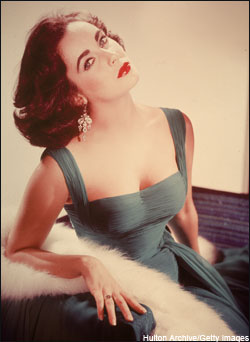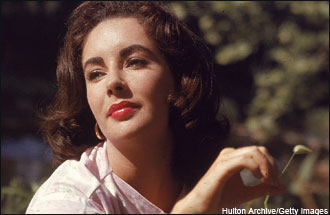 Humanitarian work, storied personal life, marked Oscar winner’s career
Humanitarian work, storied personal life, marked Oscar winner’s career
The former child star had cemented her reputation as a good actress and a stunningly gorgeous young woman by age 19. But a decade later, when both Eddie Fisher and Richard Burton left their wives for her, the violet-eyed actress went from being the world’s most beautiful woman to the world’s most wicked, at least to many.
That eventually gave way to her rep as the world’s most courageous woman, as she battled a series of illnesses, became one of the first celebs to talk openly about her substance abuse and addictions and led the fight against AIDS.
In an industry dominated by male stars in the second half of the century, Taylor was an exception. Her salary for the 1963 film “Cleopatra” was unprecedented: $1 million. Her liaisons with leading men and her eight marriages sparked plenty of controversy but did not bring down the kind of career censure that other nonmonogamous women (notably Ingrid Bergman) suffered. She remained much talked about (and sometimes even admired) even in the worst of times.
And she was the last of a breed, traveling with huge entourages, spending lavishly on diamonds and other luxuries and living a life of old-style Hollywood glamour even in the 1980s and ’90s, when most celebs insisted in interviews that they led quiet, ordinary lives.
Perhaps because of her larger-than-life image, she remained a star long after her final leading role in films (1980’s “The Mirror Crack’d”), and until the mid-1990s she still grabbed bigger headlines in newspapers and tabloids than more current actors and actresses.
However, as the Internet and fanzines changed coverage of celebs in the 21st century, Taylor barely rated a mention in her rare public appearances, which were usually tied to some charity function.
Taylor had the potential to be a great actress but claimed she never had enough ambition. When she put her mind to it, she was flawless. She amassed five Oscar nominations — not bad for someone without much ambition.
Taylor was born Feb. 27, 1932, in London to American parents. She had her first ballet lesson at age 3, and when she was 7, her parents returned to the U.S. and settled in Los Angeles, where her father operated an art gallery at the Beverly Hills Hotel.
 Her first film was “There’s One Born Every Minute,” released by Universal (where she was under contract) in 1942. After Louis B. Mayer signed her on at MGM, she appeared in “Lassie Come Home” in 1943 and the following year became a star at the age of 12 in “National Velvet” (in between there were “Jane Eyre” and “White Cliffs of Dover”).
Her first film was “There’s One Born Every Minute,” released by Universal (where she was under contract) in 1942. After Louis B. Mayer signed her on at MGM, she appeared in “Lassie Come Home” in 1943 and the following year became a star at the age of 12 in “National Velvet” (in between there were “Jane Eyre” and “White Cliffs of Dover”).
And she remained a star for more than half a century.
Several young-lady roles followed in the late ’40s, including “A Date With Judy,” “Life With Father,” “Julia Misbehaves” and 1949’s “Little Women.”
Taylor’s first grown-up romantic leading role was opposite Robert Taylor in 1949’s “Conspirator.” But it was Vincente Minnelli’s “Father of the Bride” (and its year-later sequel “Father’s Little Dividend”) that showed her promise as a leading lady.
Her marital relationships were more closely followed and speculated upon than her films. She met hotel heir Nicky Hilton in 1949, when she was 17, and married him in 1950 (when “Father of the Bride” was released); they divorced nine months later. That same year she received her high school diploma at Los Angeles’ University High School.
Her performance in 1951’s “A Place in the Sun” was the first to prove her mettle as an actress (her work was called “a minor miracle” by Variety), and her cooing come-on to Montgomery Clift, “Tell mama,” is a great moment in film history.
For the next several years, she juggled career, marriage and motherhood: In 1952 she married the much older Michael Wilding and had two sons, Michael and Christopher.
During these years, MGM (where her weekly salary quickly rose from $1,500 to $5,000) put her in bland comedies like “Love Is Better Than Ever,” costume dramas such as “Ivanhoe” and 1954’s sudsy “Rhapsody.” She took over for an ailing Vivien Leigh in “Elephant Walk,” but it didn’t do much for her career, nor did “The Last Time I Saw Paris.”
When Grace Kelly retired to princessdom, director George Stevens hired Taylor for 1956’s “Giant,” teaming her with Rock Hudson and James Dean. The following year, she received her first Oscar nomination, for “Raintree County,” opposite close friend Clift, whose face was disfigured and repaired during production (after a drunken auto accident upon leaving Taylor’s home).
Following her second divorce in 1956, she married bon vivant producer Michael Todd, by whom she had a third child, Liza.
Todd, who took home the best pic Oscar for 1956’s “Around the World in 80 Days,” died in a New Mexico plane crash in 1958. Taylor was grief-stricken as she played the lead in Tennessee Williams’ “Cat on a Hot Tin Roof,” for which she was paid $500,000 and 10% of the gross.
The film resulted in her second Oscar nom, but Taylor quickly outraged fans by pairing up with Eddie Fisher, then married to one of her best friends, Debbie Reynolds. They were married soon thereafter. She and Fisher adopted a German orphan (who later took on Richard Burton’s name to become Maria Burton).
In 1959, another Williams adaptation, “Suddenly Last Summer,” brought her a third consecutive Oscar nomination.
She finally won on her fourth straight bid, for 1960’s “Butterfield 8,” though many felt it was a sentimental win: Shortly after “Cleopatra” started lensing, she was hospitalized with pneumonia and received an emergency tracheotomy. “Hell, I even voted for her,” snapped the spurned Reynolds.
After the ceremony, Taylor fainted in a backstage restroom.
“Cleopatra” had brought her the then-unheard-of $1 million fee, though by the time it was over she had collected more than $2 million. The at-the-time most expensive movie ever made ($37 million) nearly sank 20th Century Fox; the studio had to sell off precious parcels of its backlot (which became Century City).
During the filming of “Cleopatra,” she took up with co-star Burton, even though both were married at the time. The Fisher-Reynolds-Taylor incident had provoked some public wrath, but not to the extent of this one; the Vatican went so far as to call Taylor’s affair with Burton “erotic vagrancy.” When the two finally married, their bouts with alcohol and their extravagant lifestyle (they reportedly went through $30 million) were legendary.
Some observed at the time that Taylor made Burton a star and he made her an actress. That’s an oversimplification, but certainly Taylor turned in one of her best performances in 1966’s “Who’s Afraid of Virginia Woolf” opposite Burton. Taylor won her second Oscar for her work as a blowsy, middle-aged vicious-but-tender drunk. (The character was supposedly 50, but the 34-year-old was aged for the role.)
The two also shone in Franco Zeffirelli’s 1967 film “The Taming of the Shrew”; their 11 movies together also included “The V.I.P.s” and “The Sandpiper” (both gloriously campy pics that dealt with marital infidelity, trading on their real-life reputations), “Doctor Faustus,” “The Comedians,” “Boom,” “Under Milkwood,” “Hammersmith Is Out” and the 1973 telefilm “Divorce His, Divorce Hers.”
They parodied themselves in a 1971 episode of the “The Lucy Show.” They divorced, remarried, then divorced again. After their second divorce, the pair capitalized on their notoriety by touring in Noel Coward’s “Private Lives,” which also played on Broadway. The gimmick worked, and the show sold out.
Away from Burton, Taylor had a few interesting roles. She starred opposite Marlon Brando (replacing Clift, who died shortly before principal photography) in 1967’s “Reflections in a Golden Eye,” a quirky but interesting John Huston adaptation of Carson McCullers. She also did amusing and effective turns in 1970’s “The Only Game in Town,” with Warren Beatty; 1972’s “X, Y and Zee” (or “Zee and Co.,” as it was called overseas); and “Night Watch” the following year.
But in general, the leading roles were pretty lame; though she’d been at the top of box office stars since 1960, she dropped from the list after 1968, never to return again.
“The Driver’s Seat” in 1974 and “The Blue Bird” in 1976 were barely released, a fate similar to that of 1977’s “A Little Night Music,” in which she sang “Send in the Clowns.” In 1980’s “The Mirror Crack’d,” an adaptation of an Agatha Christie mystery, she played an actress; it was her last leading role on the bigscreen.
Taylor went to Washington, marrying Republican Sen. John Warner of Virginia and for a time playing the dutiful D.C. wife — and gaining an enormous amount of weight. After a time, the marriage waned. She publicly booed his positions on women and the draft. Finally, in 1982, they divorced.
A year later she entered the Betty Ford Clinic for prescription drug and alcohol dependency.
There were some TV films such as “Return Engagement,” “Between Friends,” “Malice in Wonderland,” “Poker Alice,” “There Must be a Pony” and Williams adaptation “Sweet Bird of Youth” in 1989. She also appeared in the soaps “General Hospital” and “All My Children” and provided the voice of baby Maggie in an episode of animated series “The Simpsons.”
In 1988 she returned to the Betty Ford Clinic, where she met her eighth husband, the non-pro, two decades younger Larry Fortensky. In 1990, she almost succumbed to pneumonia again, then married Fortensky in a $1.5 million ceremony on Michael Jackson’s estate. Before separating from Fortensky in 1995, she twice had surgery for hip replacement.
In 1985, after the death of her friend Hudson, Taylor became a founding co-chairman for amfAR (the American Foundation for AIDS Research). Thereafter she crisscrossed the country and the world, calling attention to and raising funds for AIDS research and care, more so than any other celebrity. In 1993, she received the Academy of Motion Pictures Arts & Sciences’ Jean Hersholt Humanitarian Award.
In 1987, she launched Passion, her own perfume (through Chesebrough-Pond’s), which was soon generating sales of $70 million a year. In 1989, a men’s Passion was created, and in 1991 a second women’s scent, White Diamonds, was also successful. A third perfume, Black Pearls, was introduced in 1995.
She received the AFI Lifetime Achievement Award in 1993. “You make me realize how much I miss acting, but my life is full and good,” she said at the ceremony.
In 1994, she filed suit to stop production on an unauthorized TV biography but failed. The “and then I married” piece succeeded only in the ratings.
That same year, she did a humorous cameo as Wilma Flintstone’s mother in “The Flintstones.” (She had also made an appearance in the 1988 Zeffirelli film “Young Toscanini,” which was never released in the U.S.) As if to say “let bygones be bygones,” she co-starred with Reynolds, Joan Collins and Shirley MacLaine in the 2001 telepic “These Old Broads,” co-written by Reynolds’ daughter Carrie Fisher.
In May 2000, she went to a ceremony at Buckingham Palace making her a Dame of the British Empire. Taylor was always chronically late, and London’s Mail on Sunday reported, “One of her aides asked the palace courtiers how long the queen would wait if Liz were running late. They simply ignored the question and the silence was poignant.”
Taylor showed up on time.
In lieu of flowers, the family asks that contributions be made to the Elizabeth Taylor AIDS Foundation. Memorial service details will be released at a later date.




